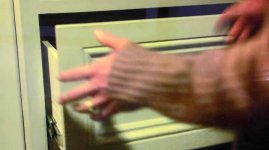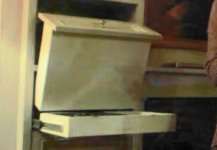smorgasbord
Member
Just started watching "Black Doves" on Netflix. There's a secret drawer in it that looks straightforward to build. Basically, it's a drawer on top of a shallow drawer, with the front of the top drawer extending down in front of the bottom, shallow drawer. The top drawer hinges in the back, so it acts as a lid for the shallow drawer. I would assume to do this for real would mean using some magnets to keep the two drawers together for "normal" use. Here's some photos:
[attachimg=1]
[attachimg=2]
And this one shows it best:
[attachimg=3]
I'm thinking this would be possible with undermount slides on the bottom/shallow drawer as well. And with the bottom slides, the sides of the top "non-secret" drawer could extend over the sides of the secret/shallow drawer to make the secret even better, although one would have to design the sides so they're not too thick for the bottom mount slides. Maybe a big rabbet in the bottom inside of the top drawer sides, so that it's only say ¼" thick at that point. Then the sides act like the front, covering the secret drawer.
Anyway, kind of fun I thought.
[attachimg=1]
[attachimg=2]
And this one shows it best:
[attachimg=3]
I'm thinking this would be possible with undermount slides on the bottom/shallow drawer as well. And with the bottom slides, the sides of the top "non-secret" drawer could extend over the sides of the secret/shallow drawer to make the secret even better, although one would have to design the sides so they're not too thick for the bottom mount slides. Maybe a big rabbet in the bottom inside of the top drawer sides, so that it's only say ¼" thick at that point. Then the sides act like the front, covering the secret drawer.
Anyway, kind of fun I thought.



